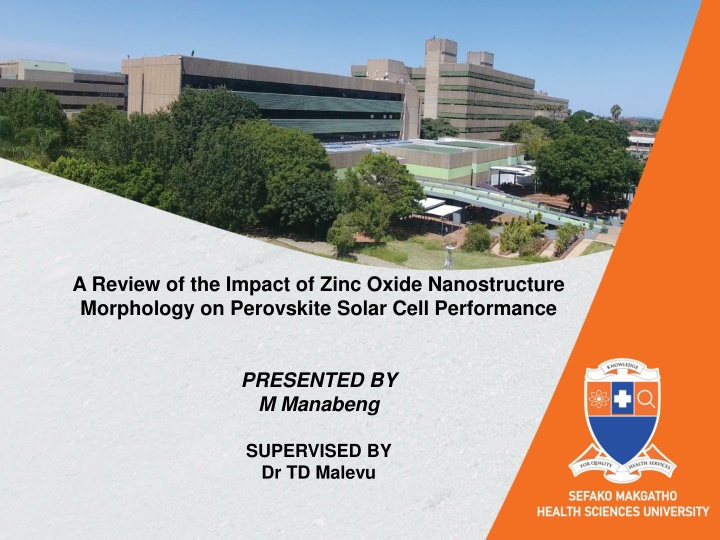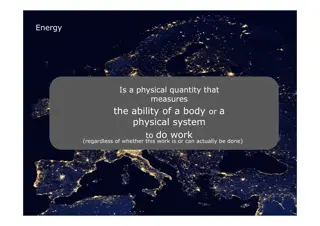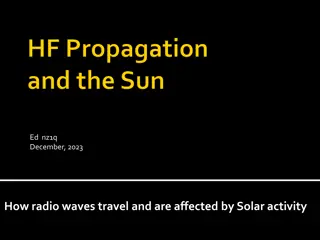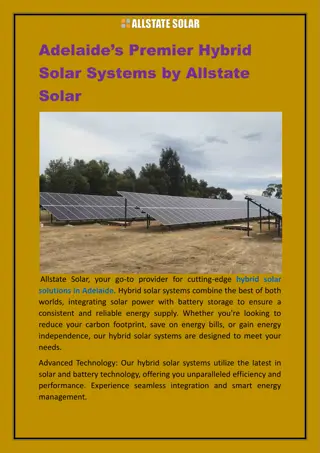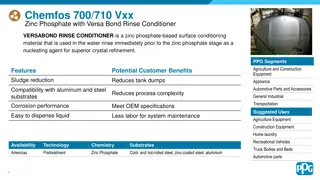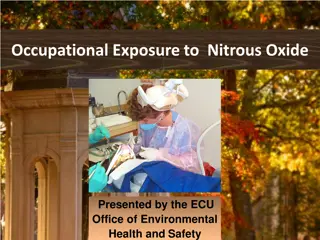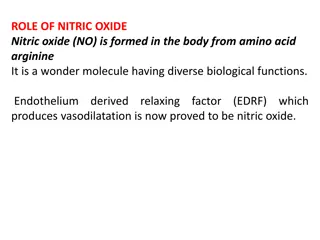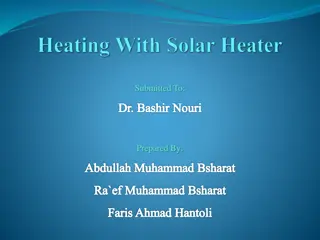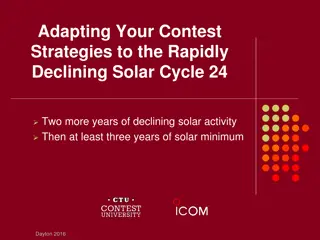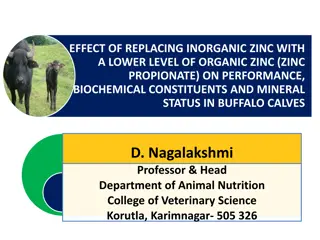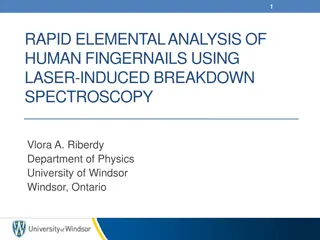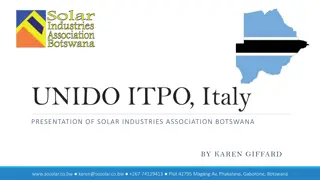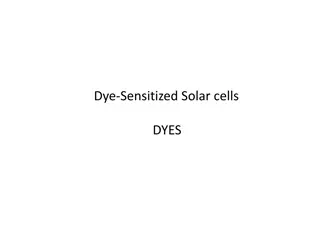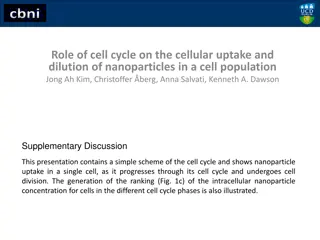Impact of Zinc Oxide Nanostructure on Perovskite Solar Cell Performance
This presentation explores the influence of zinc oxide nanostructure morphology on the performance of perovskite solar cells. Covering topics from solar energy basics to the structure of perovskite cells, it delves into synthesis methods, challenges, and future directions in this field. With a focus on sustainability and renewable energy solutions, it highlights the significance of innovative materials in enhancing solar cell efficiency.
Download Presentation

Please find below an Image/Link to download the presentation.
The content on the website is provided AS IS for your information and personal use only. It may not be sold, licensed, or shared on other websites without obtaining consent from the author.If you encounter any issues during the download, it is possible that the publisher has removed the file from their server.
You are allowed to download the files provided on this website for personal or commercial use, subject to the condition that they are used lawfully. All files are the property of their respective owners.
The content on the website is provided AS IS for your information and personal use only. It may not be sold, licensed, or shared on other websites without obtaining consent from the author.
E N D
Presentation Transcript
A Review of the Impact of Zinc Oxide Nanostructure Morphology on Perovskite Solar Cell Performance PRESENTED BY M Manabeng SUPERVISED BY Dr TD Malevu
Presentation outline INTRODUCTION SOLAR ENERGY SOLAR CELLS ZNO BASED PEROVSKITE SOLAR CELLS SYNTHESIS METHODS CHALLENGES AND FUTURE DIRECTIONS OF ZnO PEROVSKITE SOLAR CELLS CONTRIBUTION TO KNOWLEDGE REFERENCES
Introduction Global warming (??2 emmissions, deforestation, methane gas, CFCs) Ozone depletion Cost of living (reduces bills) Unfavourable weather conditions Health concerns Deforestation Gas emmissions Bad weathers
Solar Energy What is solar energy? - The type of energy generated by the sun. ADVANTAGES DISADVANTAGES Renewable resource Weather dependent Abundant Costly Reduces electricity bills Requires more space Diverse applications Can be stored in batteries
SOLAR CELLS 1st generation 3rd generation 2nd generation DSSCs Perovskite solar cells Hybrids nanomaterials High efficiency + Thin-films Lightweight Less expensive Less stable < 20% = 25% Flexible thin-film PV Stable lifespan Less expensive low efficiency Wafer based PV cells High efficiency Stable lifespan Expensive + Heavy Small lab-based PV cells Well-developed and Commercial available in PV market
PEROVSKITE SOLAR CELLS Lev Alekseyevich Perovski (1792-1856) Tsutomu Miyasaka Produced the first perovskite solar cell in 2009
PEROVSKITE STRUCTURE Basic crystal structure ABX3 ABX3 B SITE CATION- Mn^2+, Cd^2+, Cu2+, Pb^2+
Perovskite solar cells ETL ZnO TiO2
CONT national renewable energy laboratory
WHY ZINC OXIDE Non toxic Cheap to synthesize Wide band gap of 3,37 eV that other metal oxides Large binding energy of 60 MeV Biocompatible High infrared reflectivity Chemically stable High electron mobility A range of morphology
1D nanorods 2D nanopellets 3D snowflakes
Synthesis methods Method Mode Pros Cons Chemical Hydrothermal, precipitation, deposition, micro-elusion sol-gel, microwave, thermal prylosis, bath deposition, Supports many precursors, and conditions. Allows tuning of morphology, size, and geometry A large number of surfactants, poor solubility for some precursors, poor temperature stability of micro-emulsions, and pH issues Physical Laser ablation, ball milling, melt mixing, physical vapour deposition, sputtering Technically simple, chemically pure, uniform nanoparticles, applicable zinc surface Needs higher energy, temperature and pressure, are expensive, and radiation fallout Green Plant extraction, biochemical, microorganisms Cost-effective, fewer toxic chemicals, use natural antimicrobe activity Hard to tune size, shape, and growth rate. Endotoxin fallout, rarely reported in the literature
Challenges and Future directions of ZnO Based PSCs Stability issues Extrinsic Intrinsic Band structure and defects Thermodynamics and phase Oxidation and photo oxidation stability Thermochemical Electrode Device thermal stability Moisture stability Light stability stability degradation
EXPECTED CONTRIBUTION OF EXPECTED CONTRIBUTION OF KNOWLEDGE KNOWLEDGE Manabeng, M., Mwankemwa, B.S., Ocaya, R.O., Motaung, T.E. and Malevu, T.D., 2022. A Review of the Impact of Zinc Oxide Nanostructure Morphology on Perovskite Solar Cell Performance. Processes, 10(9), p.1803.
REFERENCES REFERENCES 1. Mahmood, K., Swain, B.S. and Amassian, A., 2014. Double-layered ZnO nanostructures for efficient perovskite solar cells. Nanoscale, 6(24), pp.14674-14678. 2. Xu, F., Dai, M., Lu, Y. and Sun, L., 2010. Hierarchical ZnO nanowire nanosheet architectures for high power conversion efficiency in dye- sensitized solar cells. The Journal of Physical Chemistry C, 114(6), pp.2776-2782. 3. Feng, Y., Ji, X., Duan, J., Zhu, J., Jiang, J., Ding, H., Meng, G., Ding, R., Liu, J., Hu, A. and Huang, X., 2012. Synthesis of ZnO@ TiO2 core shell long nanowire arrays and their application on dye-sensitized solar cells. Journal of Solid State Chemistry, 190, pp.303-308. 4. Duan, J., Xiong, Q., Wang, H., Zhang, J. and Hu, J., 2017. ZnO nanostructures for efficient perovskite solar cells. Journal of Materials Science: Materials in Electronics, 28(1), pp.60-66. 5. Djuri i , A.B. and Leung, Y.H., 2006. Optical properties of ZnO nanostructures. small, 2(8 9), pp.944-961. 6. Pal, U., Serrano, J.G., Santiago, P., Xiong, G., Ucer, K.B. and Williams, R.T., 2006. Synthesis and optical properties of ZnO nanostructures with different morphologies. Optical Materials, 29(1), pp.65-69. 7. Fodjouong, G.J., Feng, Y., Sangare, M. and Huang, X., 2013. Synthesis of ZnO nanostructure films by thermal evaporation approach and their application in dye-sensitized solar cells. Materials science in semiconductor processing, 16(3), pp.652-658. 8. Li, D. and Haneda, H., 2003. Morphologies of zinc oxide particles and their effects on photocatalysis. Chemosphere, 51(2), pp.129-137. 9. Duan, J., Xiong, Q., Wang, H., Zhang, J. and Hu, J., 2017. ZnO nanostructures for efficient perovskite solar cells. Journal of Materials Science: Materials in Electronics, 28(1), pp.60-66. 10. Shouli, B., Liangyuan, C., Dianqing, L., Wensheng, Y., Pengcheng, Y., Zhiyong, L., Aifan, C. and Liu, C.C., 2010. Different morphologies of ZnO nanorods and their sensing property. Sensors and Actuators B: Chemical, 146(1), pp.129-137.
Acknowledgments Sent to Supervisor Dr. Malevu T.D Financial Support National Research Foundation
